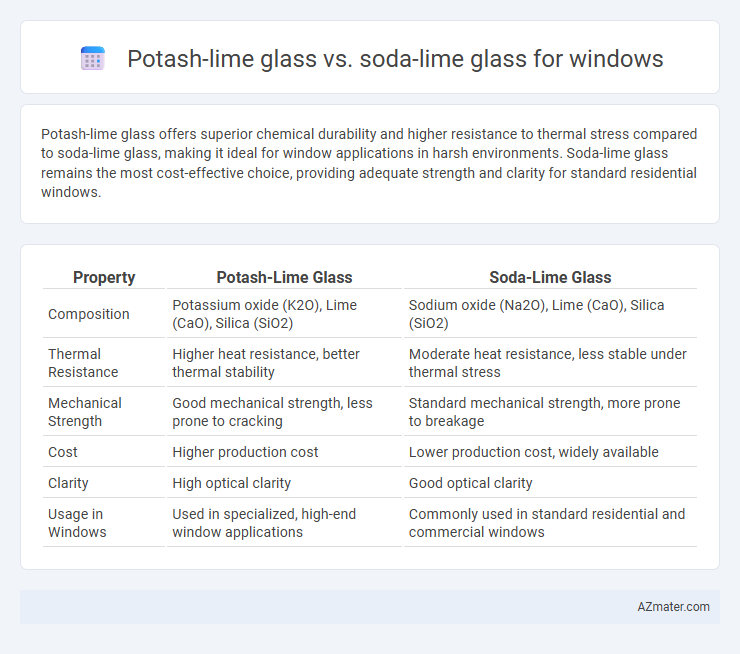Potash-lime glass offers superior chemical durability and higher resistance to thermal stress compared to soda-lime glass, making it ideal for window applications in harsh environments. Soda-lime glass remains the most cost-effective choice, providing adequate strength and clarity for standard residential windows.
Table of Comparison
| Property | Potash-Lime Glass | Soda-Lime Glass |
|---|---|---|
| Composition | Potassium oxide (K2O), Lime (CaO), Silica (SiO2) | Sodium oxide (Na2O), Lime (CaO), Silica (SiO2) |
| Thermal Resistance | Higher heat resistance, better thermal stability | Moderate heat resistance, less stable under thermal stress |
| Mechanical Strength | Good mechanical strength, less prone to cracking | Standard mechanical strength, more prone to breakage |
| Cost | Higher production cost | Lower production cost, widely available |
| Clarity | High optical clarity | Good optical clarity |
| Usage in Windows | Used in specialized, high-end window applications | Commonly used in standard residential and commercial windows |
Introduction to Potash-Lime and Soda-Lime Glass
Potash-lime glass, composed primarily of potassium oxide, calcium oxide, and silica, exhibits superior chemical durability and higher refractive index compared to soda-lime glass, which mainly contains sodium oxide, calcium oxide, and silica. Soda-lime glass dominates window manufacturing due to its cost-effectiveness and good mechanical strength, while potash-lime glass is favored for specialized applications requiring enhanced resistance to weathering and thermal stability. Understanding the distinct composition and properties of potash-lime versus soda-lime glass is essential for selecting the ideal material for window performance and longevity.
Chemical Composition Differences
Potash-lime glass contains potassium oxide (K2O) typically around 5-12%, which increases its chemical durability and resistance to water corrosion compared to soda-lime glass that primarily includes sodium oxide (Na2O) at about 12-15%. Soda-lime glass features a higher sodium oxide content, making it more susceptible to chemical attack but less expensive and easier to produce. The presence of potassium oxide in potash-lime glass results in lower thermal expansion and improved stability, influencing its suitability for window applications requiring enhanced durability.
Historical Development and Usage
Potash-lime glass, historically prominent in early European window production during the Middle Ages, offered superior chemical durability due to its potassium oxide content, making it less prone to weathering compared to soda-lime glass. Soda-lime glass, developed later and now dominating modern window manufacturing, contains sodium oxide and calcium oxide, providing cost-effective mass production and excellent optical clarity. The transition from potash-lime to soda-lime glass in window applications reflects advances in industrial glassmaking and the demand for affordable, large-scale architectural glazing.
Optical Properties for Windows
Potash-lime glass features lower refractive index and higher optical clarity compared to soda-lime glass, resulting in less distortion and improved light transmission for windows. Its superior resistance to UV-induced degradation preserves transparency over time, enhancing visual performance in window applications. Soda-lime glass, while more common and cost-effective, exhibits slightly higher light absorption and lower optical homogeneity, making potash-lime glass preferable for premium optical clarity in architectural glazing.
Mechanical Strength Comparison
Potash-lime glass exhibits higher mechanical strength and better resistance to impact compared to soda-lime glass, making it more durable for window applications. The increased alkali content in potash-lime glass enhances its flexural strength and reduces brittleness under stress. This superior mechanical performance results in improved longevity and safety in construction environments where glass windows are exposed to dynamic loads.
Durability and Weather Resistance
Potash-lime glass offers enhanced durability compared to soda-lime glass due to its higher resistance to mechanical stress and chemical corrosion. In weather resistance, potash-lime glass demonstrates superior performance in withstanding UV radiation and thermal fluctuations, reducing the risk of surface degradation and maintaining clarity over time. Soda-lime glass, while more common and cost-effective, is more susceptible to weathering effects, including slight surface etching and decreased structural integrity under prolonged exposure to harsh environmental conditions.
Energy Efficiency and Insulation
Potash-lime glass offers superior thermal insulation properties compared to soda-lime glass, reducing heat transfer and enhancing energy efficiency in windows. This type of glass has a lower thermal conductivity, which helps maintain indoor temperature and lowers heating and cooling costs. Soda-lime glass, while more common and cost-effective, generally provides less insulation, making potash-lime glass a better choice for energy-efficient window applications.
Environmental Impact and Sustainability
Potash-lime glass offers improved recyclability and lower energy consumption during production compared to soda-lime glass, which relies heavily on sodium oxide and limestone, leading to higher carbon emissions. The raw materials for potash-lime glass, primarily potassium carbonate, are more sustainable and less impactful on ecosystems than the sodium and calcium sources in soda-lime glass. Choosing potash-lime glass for windows supports reduced environmental footprint and enhanced sustainability in building materials.
Cost Analysis and Commercial Availability
Potash-lime glass generally incurs higher production costs than soda-lime glass due to more expensive raw materials and specialized manufacturing processes, leading to increased price points for window applications. Soda-lime glass dominates the commercial market with widespread availability, benefiting from large-scale production and cost efficiencies that make it the preferred choice for standard window installations. Cost analysis reveals soda-lime glass offers superior affordability and accessibility, while potash-lime glass is typically reserved for niche applications where its specific properties justify the elevated expense.
Conclusion: Choosing the Right Glass for Windows
Potash-lime glass offers superior thermal stability and chemical resistance, making it ideal for windows in harsh environments, while soda-lime glass is more cost-effective and widely used for standard window applications due to its balanced strength and clarity. The decision between potash-lime and soda-lime glass hinges on specific requirements such as durability, environmental exposure, and budget constraints. For high-performance and longevity needs, potash-lime glass is preferable, whereas soda-lime glass suits general residential and commercial window installations.

Infographic: Potash-lime glass vs Soda-lime glass for Window
 azmater.com
azmater.com